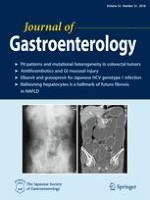Published in:

01-12-2018 | Original Article—Liver, Pancreas, and Biliary Tract
Real-world virological efficacy and safety of elbasvir and grazoprevir in patients with chronic hepatitis C virus genotype 1 infection in Japan
Authors:
Hidenori Toyoda, Masanori Atsukawa, Koichi Takaguchi, Tomonori Senoh, Kojiro Michitaka, Atsushi Hiraoka, Shinichi Fujioka, Chisa Kondo, Tomomi Okubo, Haruki Uojima, Toshifumi Tada, Hirohito Yoneyama, Tsunamasa Watanabe, Toru Asano, Toru Ishikawa, Hideyuki Tamai, Hiroshi Abe, Keizo Kato, Kunihiko Tsuji, Chikara Ogawa, Noritomo Shimada, Etsuko Iio, Akihiro Deguchi, Ei Itobayashi, Shigeru Mikami, Akio Moriya, Hironao Okubo, Joji Tani, Akihito Tsubota, Yasuhito Tanaka, Tsutomu Masaki, Katsuhiko Iwakiri, Takashi Kumada
Published in:
Journal of Gastroenterology
|
Issue 12/2018
Login to get access
Abstract
Background
The real-world virological efficacy and safety of an interferon (IFN)-free direct-acting antiviral (DAA) therapy with elbasvir (EBR) and grazoprevir (GZR) were evaluated in Japanese patients chronically infected with hepatitis C virus (HCV) genotype 1.
Methods
The rate of sustained virologic response (SVR) and safety were analyzed in patients who started the EBR/GZR regimen between November 2016 and July 2017. SVR rates were compared based on patient baseline characteristics.
Results
Overall, 371 of 381 patients (97.4%) achieved SVR. Multivariate analysis identified a history of failure to IFN-free DAA therapy and the presence of double resistance-associated substitutions (RASs) in HCV non-structural protein 5A (NS5A) as factors significantly associated with failure to EBR/GZR treatment. The SVR rates of patients with a history of IFN-free DAA therapy and those with double RASs were 55.6 and 63.6%, respectively. In all other subpopulations, the SVR rates were more than 90%. There were no severe adverse events associated with the treatment.
Conclusions
The EBR/GZR regimen yielded high virological efficacy with acceptable safety. Patients with a history of failure to IFN-free DAA therapy or with double RASs in HCV-NS5A remained difficult to treat with this regimen.





